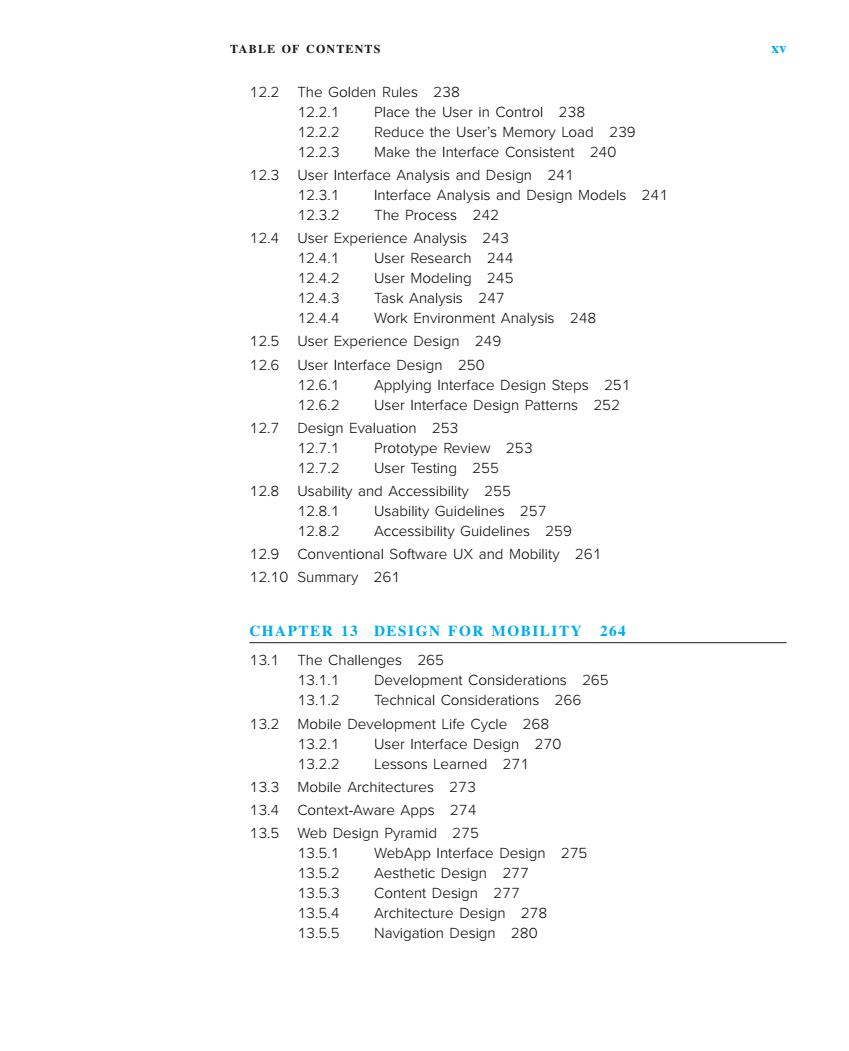正在加载图片...

TABLE OF CONTENTS 12.2 The Golden Rules 238 12.2.1 Place the User in Control 238 1222 Reduce the User's Memory Load 239 12.2.3 Make the Interface Consistent 240 12.3 User Interface Analysis and Design 241 1231 Interface Analysis and Design Models 241 12.3.2 The Process 242 12.4 User Experience Analysis 243 1241 User Research 244 12.4.2 User Modelir ng 245 12.4.3 Task Analysis 247 1244 Work Environment Analysis 248 12.5 User Experience Design 249 12.6 User Interface Design 250 12.6.1 Applying Interface Design Steps 251 12.6.2 User Interface Design Patterns 252 12.7 Design Evaluation 253 12.7. Prototype Review 253 12.7.2 User Testing 255 12.8 Usability and Accessibility 255 12.8. Usability Guidelines 257 12.8.2 Accessibility Guidelines 259 12.9 Conventional Software UX and Mobility 261 12.10 Summary 261 CHAPTER 13 DESIGN FOR MOBILITY 264 13.1 The Challenges 265 1311 Development Considerations 265 13.1.2 Technical Considerations 266 13.2 Mobile Development Life Cycle 268 132. User Interface Design 270 13.2.2 Lessons Learned 271 13.3 Mobile Architectures 273 13.4 Context-Aware Apps 274 13.5 Web Design Pyramid 275 13.5. WebApp Interface Design 275 13.52 Aesthetic Design 277 13.5.3 Content Design 277 13.5.4 Architecture Design 278 13.5.5 Navigation Design 280TABLE OF CONTENTS xv 12.2 The Golden Rules 238 12.2.1 Place the User in Control 238 12.2.2 Reduce the User’s Memory Load 239 12.2.3 Make the Interface Consistent 240 12.3 User Interface Analysis and Design 241 12.3.1 Interface Analysis and Design Models 241 12.3.2 The Process 242 12.4 User Experience Analysis 243 12.4.1 User Research 244 12.4.2 User Modeling 245 12.4.3 Task Analysis 247 12.4.4 Work Environment Analysis 248 12.5 User Experience Design 249 12.6 User Interface Design 250 12.6.1 Applying Interface Design Steps 251 12.6.2 User Interface Design Patterns 252 12.7 Design Evaluation 253 12.7.1 Prototype Review 253 12.7.2 User Testing 255 12.8 Usability and Accessibility 255 12.8.1 Usability Guidelines 257 12.8.2 Accessibility Guidelines 259 12.9 Conventional Software UX and Mobility 261 12.10 Summary 261 CHAPTER 13 DESIGN FOR MOBILITY 264 13.1 The Challenges 265 13.1.1 Development Considerations 265 13.1.2 Technical Considerations 266 13.2 Mobile Development Life Cycle 268 13.2.1 User Interface Design 270 13.2.2 Lessons Learned 271 13.3 Mobile Architectures 273 13.4 Context-Aware Apps 274 13.5 Web Design Pyramid 275 13.5.1 WebApp Interface Design 275 13.5.2 Aesthetic Design 277 13.5.3 Content Design 277 13.5.4 Architecture Design 278 13.5.5 Navigation Design 280